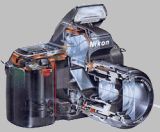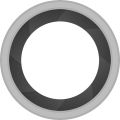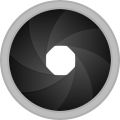Some Technical Basics
Shutter Speed
 The shutter speed of a camera determines how long the film or digital sensor is exposed to the light. Most point and shoot cameras don't allow you to manually set the shutter speed. It is a common feature on DSLRs though. Shutter speeds can range anywhere from 1/1000 sec up to 30+ seconds. When shooting sports or fast moving objects, faster shutter speeds will ensure a sharper picture, essentially freezing the subect in motion. Longer shutter speeds are better suited for low-light situiations and are used to create certain effects within the image. Most notably, a slower shutter speed can be used to give flowing water a soft white texture.
The shutter speed of a camera determines how long the film or digital sensor is exposed to the light. Most point and shoot cameras don't allow you to manually set the shutter speed. It is a common feature on DSLRs though. Shutter speeds can range anywhere from 1/1000 sec up to 30+ seconds. When shooting sports or fast moving objects, faster shutter speeds will ensure a sharper picture, essentially freezing the subect in motion. Longer shutter speeds are better suited for low-light situiations and are used to create certain effects within the image. Most notably, a slower shutter speed can be used to give flowing water a soft white texture.
Aperture

 The aperture [also known as the f-stop] is the opening in the lens which lets light through to produce the image. The aperture of the lens determines the depth-of-field of the image. Some lenses have a fixed aperture, while others give you the option of changing the size of the opening.The aperture of a lens can vary in size from f/1.2 - f/22. Larger f-stop numbers correlate to a smaller opening in the lens and result in a much greater depth-of-field. Likewise, smaller f-stop numbers give you a much shallower depth-of-field. Lower f-stops also allow for use of a faster shutter speed. Combinations of fast shutter speeds and small f-stops are typically used when shooting at a sporting event.
The aperture [also known as the f-stop] is the opening in the lens which lets light through to produce the image. The aperture of the lens determines the depth-of-field of the image. Some lenses have a fixed aperture, while others give you the option of changing the size of the opening.The aperture of a lens can vary in size from f/1.2 - f/22. Larger f-stop numbers correlate to a smaller opening in the lens and result in a much greater depth-of-field. Likewise, smaller f-stop numbers give you a much shallower depth-of-field. Lower f-stops also allow for use of a faster shutter speed. Combinations of fast shutter speeds and small f-stops are typically used when shooting at a sporting event.
ISO
ISO is a rating of the sensitivity of the film or sensor to light. Lower ISO numbers [e.g. 100, 200] mean that the light collection medium is not as sensitive to light as a sensor with a higher ISO [e.g. 800, 1600]. With increased sensitivity, you don't need to use as long of a shutter speed to get a correct exposure. But with the increased sensitivity comes a loss of sharpness in the picture. A grain - or "noise" - can appear on some images created with a highly-sensitive medium.

 The shutter speed of a camera determines how long the film or digital sensor is exposed to the light. Most point and shoot cameras don't allow you to manually set the shutter speed. It is a common feature on DSLRs though. Shutter speeds can range anywhere from 1/1000 sec up to 30+ seconds. When shooting sports or fast moving objects, faster shutter speeds will ensure a sharper picture, essentially freezing the subect in motion. Longer shutter speeds are better suited for low-light situiations and are used to create certain effects within the image. Most notably, a slower shutter speed can be used to give flowing water a soft white texture.
The shutter speed of a camera determines how long the film or digital sensor is exposed to the light. Most point and shoot cameras don't allow you to manually set the shutter speed. It is a common feature on DSLRs though. Shutter speeds can range anywhere from 1/1000 sec up to 30+ seconds. When shooting sports or fast moving objects, faster shutter speeds will ensure a sharper picture, essentially freezing the subect in motion. Longer shutter speeds are better suited for low-light situiations and are used to create certain effects within the image. Most notably, a slower shutter speed can be used to give flowing water a soft white texture.

 The aperture [also known as the f-stop] is the opening in the lens which lets light through to produce the image. The aperture of the lens determines the depth-of-field of the image. Some lenses have a fixed aperture, while others give you the option of changing the size of the opening.The aperture of a lens can vary in size from f/1.2 - f/22. Larger f-stop numbers correlate to a smaller opening in the lens and result in a much greater depth-of-field. Likewise, smaller f-stop numbers give you a much shallower depth-of-field. Lower f-stops also allow for use of a faster shutter speed. Combinations of fast shutter speeds and small f-stops are typically used when shooting at a sporting event.
The aperture [also known as the f-stop] is the opening in the lens which lets light through to produce the image. The aperture of the lens determines the depth-of-field of the image. Some lenses have a fixed aperture, while others give you the option of changing the size of the opening.The aperture of a lens can vary in size from f/1.2 - f/22. Larger f-stop numbers correlate to a smaller opening in the lens and result in a much greater depth-of-field. Likewise, smaller f-stop numbers give you a much shallower depth-of-field. Lower f-stops also allow for use of a faster shutter speed. Combinations of fast shutter speeds and small f-stops are typically used when shooting at a sporting event.
